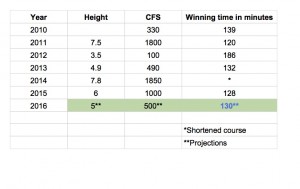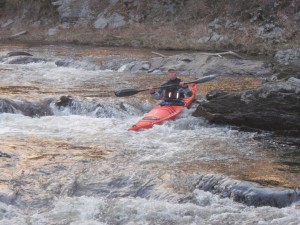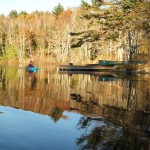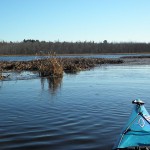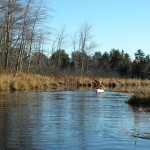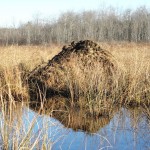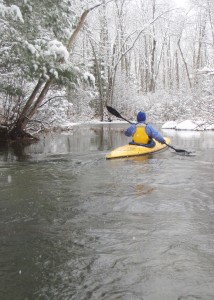The following is part two of a two (or three) part guest blog by Leslie Gregory of Swanville, Maine. Paddling with Leslie, I am frequently reminded that when seeking adventure or beauty, it is not always necessary to look far from home.
——————————————————————————————————————-
October 26 I brought River Runner back from the lake to venture down for autumn’s waning afternoons. I launched from the dam and noticed the river wasn’t as low as last spring. But as I rounded the bend and came upon an 8 ft beaver dam, I was stunned at how severe a drop had been created; the water was low and sluggish; easy to spot small trickles I hoped would keep me buoyant.
All week I couldn’t wait to get out of school and hurry home to take advantage of the warm and sunny afternoons. Daylight savings was yet to come, and I wanted to weave the golden reflections into my thoughts, offer optimism and ponder beauty. I knew I was a ridiculous sight, biking across the street, wearing my life preserver and spray skirt, but the bike ride let me maximize the daylight when minutes counted.
Below, the river widened and deepened a bit with familiar long lengths of skyway, and I’d feel my boat drift sideways around the turns to enter into another stretch. I noticed slender pickets of sticks planted in the edge of the river banks, tagged with neon orange. Signs of trapping. The beaver dams and lodges are up above; here where the river widens out there are muskrat and otters as well.
I love getting out to the pond to feel the magic of the afternoon light. The new moon lingers in the western sky. There’s a turtle basking on a rock in the pickerel weeds. There’s peace in the valley until a dog up on the hill senses my presence and starts barking. Reluctantly I paddle home, breathing in the deepening purple shadows, grateful I can enjoy such tranquil moments.
Nov 6 Today we started from where the lake empties into the river with the determination to paddle all the way down until we got to the ocean. It’s been unseasonably warm and I was in a t shirt all afternoon. The river meanders for miles, drops into subsequent ponds and then meets a series of dams, aka portages. We worked our way over shallow rapids, climbed over stone walls and found ourselves in a golden sunbathed afternoon, the light low and intense. We had to give up because the water got so low, but spring will find me exploring this part of the river. We walked along a gorge between two falls. Maybe this is where the class 2 & 3 whitewater is. I can’t wait to find out!
Nov 15 Took the canoe out of the river today. I’d been planning it for weeks: rather than drive across the street w/ a trailer, I was going to shuttle to Smart Road, leave my car and trailer, bike home, run across the street and paddle down. It was going to have to be a school day, so I kept conniving til I finally picked the day, hurried home and changed up, but still it was 3:30 before I launched.
Canoeing is different than kayaking. Handling a T paddle can be mastered but it is a different motion and much slower. To keep a canoe tracking properly is a challenge when you’re solo. Suffice it to say, I took out in the dark. But on the way! The afternoon light spilled golden on the river grass, the calm waters reflecting skyfuls of trees, long highway of woods and sparkle. . . I kept scaring out a bunch of ducks, they’d fly downriver 200 yards only to sound their alarm again as I approached.Some otters swam in front of me, having survived the traps that had been laid out for them. There are plenty of beaver dams and lodges on this river. There is a dam up near the lake that is quite steep and 6- 8 feet out of the water when it’s low water. I think trapping a few beaver is probably okay. But it pains me to see traps set within 6 feet of the beaver lodges. It makes me root for the beavers.
The day’s light gave way to darkened smudges of purple streaks, the water took on a lustrous white in the rising moonlight. In a kayak I could have paddled the 6 miles in less than an hour but it took me all of two hours in the canoe, with hard paddling. I snuck up on the take out in the dark, savoring the waning light and deepening shadows.
Nov 22 Today I was given the gift of time and found myself on the river by 1:30. A forecast for rain and snow always makes me anxious of how many times I have left to paddle. I mostly say I’ll paddle through the 2nd snowstorm of the season, thus promising myself the thrill of paddling along snow lined banks, the trees lined with white filligree. But today it was all of 40 degrees, and the sunlight was dazzling. I heard hissing and cracking which I discovered was the movement from my boat pushing thin sheets of ice further into the muddy banks. I made a game of it, rounding corners to push the ice out further and then herding the big sheets to the side. The ice is a reminder that the water is freezing. A capsize here might only land me in a few feet of water, but extracting myself from the mud and grasslands would be arduous and dangerous. No worries, the river is smooth as glass with 6 foot grasses towering over me and standing tall in reflection, and there is no reason to capsize.. The most dangerous part of the endeavor is getting in the boat with the mud all around and trying to rinse my feet off . As I push off the mud ridden bank with my paddle, my boat rocks a bit, but I ride the rolling motions and launch, smiling that I am on an adventure less than a half mile from home. My thoughts on the river are clear and unfettered, taking in only the pristine and simple beauty of the long grasses, the satin gloss of water, the crack of the ice gathering in the shadow of the timothy and cattails. The pond is lined with silver sumac, having been the first to parade and then shed their scarlet leaves 6 weeks ago Where the water is most shallow, ice has formed, and I find myself riding and crashing across a sheet of thin glass to get on the pond. A breeze stirs gently, pushing from the north. The silhouettes of geese point south. The air is brisk, still unseasonably warm, but just a day and 30 degrees away from impending winter. Soon the ice will block my passage onto the pond. Today is a gift. I know how to savor these moments, and when the geese return in the spring, I’ll be down here to welcome them.
Nov 25 Thanksgiving was a frenetic blur of housecleaning, cooking, hugging and ping pong. We had 6-7 inches dumped in the river valley, and Bax took the snowmobile across the field for a spin. I tried skiing but the snow was wet and heavy, and I couldn’t help but think how lovely the river would be with its muddy banks snow capped and close. We finally relaxed on Friday and slid down the snowy bank into the river. What a launch! The contrast of the tall grasses and the snow was lovely. We paddled fast around the bends, our kayaks drifting sideways as we rounded the corners. The ice was forming in thick bands along the edges, and we had to carve our turns wider. There was the temptation of riding up on the ice and coming down on it ice-breaker style, trying to maintain balance on the round rocker of the kayaks.
As we approached the pond, the ice closed in on top of the sallow grasses. The pond appeared to be a solid glass surface, frozen solid. I tasted reluctance, not wanting to let the seasons change. We had to turn back and head up river. The warmth of the sun gave little comfort as I contemplated our afternoon sojourn cut short. I cheered up immensely when my paddling partner said, “Well, we can always do it again.” Yes indeed. As we passed the put in, the river got narrower, shallower, and eventually impassable, so we turned and headed back down, languishing in the afternoon light. When we got to the ice dam before the pond, the wind picked up. Suddenly we could see that the pond was not frozen some 40 yards out. There were some fissures in the ice, so we probed them, lining our boats up, riding up on the ice and pushing huge sheets apart with our hands, pushing ourselves out into the ice and moving it until we finally made it to the chill waters of the pond. I breathed in the waning afternoon light and spotted a sliver of moon in the western sky. Suddenly we were crossing the pond and heading a few stretches more downriver.
The days of paddling in 2011 are numbered, but we made it last a little longer!
Dec 05 Turns out the ice melted and the river rose. It’s two weeks later and I’m back to early sunsets on the pond. I’d write more but Goose River is calling me.
